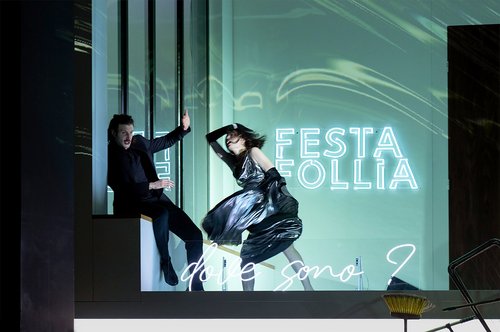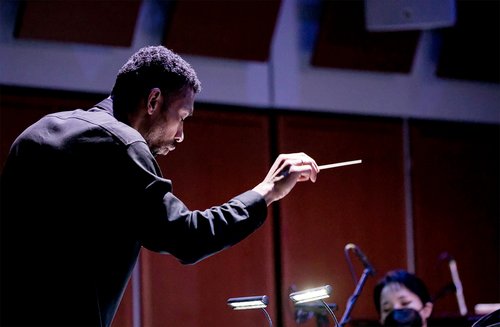From Text to Textile: Serebrennikov’s Misunderstood Don Carlo
Kirill Serebrennikov’s controversial new production of Verdi's Don Carlo at the Vienna State Opera has divided audiences and critics. While visually striking and conceptually rich, its intellectual depth and contemporary staging has left many struggling to connect, provoking mixed reactions and violent debate.
Kirill Serebrennikov's (b. 1969) controversial new production of Giuseppe Verdi's opera Don Carlo at the Vienna State Opera has divided audiences more than ever before, and judging by reviews in the German language press, the critics were not onside. At the premiere last month, conductor Philippe Jordan raised a white handkerchief on his baton to pacify the audience, who were creating a disturbance by openly voicing their dissatisfaction during the performance. What caused such strong and unprovoked reactions? At root, I think were its excessive intellectuality and at the same time a refined, almost emotionless performance of a production which hit at the heart of the conflict ranging through Europe and within tangible distance of the Austria capital.
When the Vienna Opera’s director Bogdan Roščić asked Kirill Serebrennikov (b. 1969) to produce an Italian version of Giuseppe Verdi’s opera (already an unusual request as the Vienna Opera is concurrently staging two versions of Don Carlo, in Italian and French), the discussion immediately turned to the conceptual impossibility of revising a score based on Friedrich Schiller’s drama at the royal court, set in Madrid in 1568. King Philip II of Spain takes away French Princess Elisabeth of Valois, the potential bride of his mentally unstable son Don Carlo, who then becomes his stepmother instead of a future wife, and core of the plot shifts painfully on the eternal conflict between duty and feeling, state necessity and human affection, between the outer shell of a person’s public status and role and his or her inner world.
This bifurcation of the outer and the inner lies at the heart of Serebrennikov’s approach. On stage we see avatar doppelgangers of the main characters, dressed in ceremonial robes perfectly recreated from famous portraits of Philip II, Don Carlo, Elizabeth of Valois and Princess Eboli. These doppelgangers cast black shadows of their official roles onto the live performers, who appear in black replicas of historical costumes in moments of great dramatic confrontation.
Kirill Serebrennikov, in a stroke of madcap genius, moves the action from the Spanish court to a Japanese style costume institute, where fabric samples and pieces of clothing from different eras are meticulously researched, preserved, and stored under special conditions. In Kyoto there is a textile institution which exhibits old and fragile costumes in which DNA samples from their previous owners are preserved, of whom otherwise only ashes remain…
The biblical text “thou return unto the ground; for out of it wast thou taken and for dust thou art, and unto dust.” (Genesis 3:19) is transformed into textiles: when a monk sings “Carlo, il sommo imperatore, non è più che muta polve” (Charles, the supreme Emperor, is now no more than silent dust), a worker at the costume institute pulls a box out of a cold storage resembling a morgue which contains a half-decayed garment of the greatest emperor of the Habsburg dynasty, Charles V (1500–1558) and the entire play ends with the destruction of this relic.
It seems that moving the historical realities with real historical figures to contemporary life was perhaps one step too far for the Viennese theatre goers, or perhaps it was the specifics of this ingenious and radical shift, some delighting and some rejecting the concept of an office romance between employees of the Costume Institute. Those who looked more favourably on the production cited the perfect creation of the mise-en-scene, the magnificent costumes and the movements of the singers around stage which were timed to sheer perfection. Others complained that the stage was too brightly lit up, conflicting with the usual gloominess of Verdi’s musical palette. And many found it hard to accept that the entire action takes place on one set, a light grey marble pavilion. Also, in places the actions of the characters intentionally diverged from their lines. And apparently no-one, however positive or otherwise towards the production, liked Serebryannikov’s decision to turn the climactic burning of dissidents into an an eco-activist protest during an exhibition on the costumes of the Spanish Habsburg era.
Although seeminly one step too far, this did perfectly fit the self-contained logic of this contemporary production: the Royal Habsburg dynasty with its imperial ambitions, pressurizing small countries and communities of people living by their own rules is symbolically represented in video sequences depicting, on the one hand, the euphoria of consumer ecstasy and, on the other hand, the inhuman and often dangerous conditions of fabric production. Yet perhaps what was most disturbing for audiences today is that ostensibly Verdi’s ‘Don Carlos’ war is now raging in the centre of Europe as a confrontation between ‘imperial’ Russia and ‘dissident’ Ukraine. It is a very real tragedy destroying families and homes, with relatives and friends on both sides of the front, painfully close to home.
Kirill Serebrennikov’s performance raises with a renewed vigour the question of the relationship between art and reality. As one of our greatest artists today with his raw and powerful creative intuition, Kirill Serebrennikov has created a work whose significance goes far beyond the theatrical depiction on stage of the subject of one single opera. It leads us to question what is the mission of an artist now, is it to placate our fears or exaggerate reality to wake us out of our collective stupor?
The central character who oversees the smooth running of the cult of dead functions at the Costume Institute becomes the Grand Inquisitor, played by Russian bass Dmitry Ulyanov. I think his voice and vocal technique are the living, artistic axis of this production, complemented by the fine, academic, loud, and passionate sounds of the Wiener Philharmoniker under conductor Philippe Jordan. Dependent on the Grand Inquisitor is his own superior Philip II, transformed in this production into the Director of the Institute and played by Italian bass Roberto Tagliavini who delivers a flat and emotionless performance, almost like a quarterly report sending the audience to sleep – despite being conceptually sound.
The part of Rodrigo di Posa, turned into an eco-activist (perhaps Kirill Serebrennikov’s alter-ego?), was brilliantly performed by Canadian baritone Étienne Dupuis. Smooth, elegant diminuendos and fermatas captivated with bel canto beauty although one wonders whether this exquisite interpretation really embodied the rebellious nature of Schiller’s original man of honour and conscience. Lithuanian soprano Asmik Grigorian gave powerful highs and brought dramatic tension in the role of Elisabeth of Valois, but the role itself in this production did not fit the temperament of this otherwise exceptional singer. Grigoryan in the role of the obedient puppet and soulless carcass of Elizabeth is critically unsuitable for a performer who is best loved by audiences for her charismatic personality and is best when playing herself. This in part dilutes the drama which lies at the heart of the narrative. Grigorian’s voice is unparalleled and she acts beautifully however does not evoke any sympthy for her tragic heroine in a production which is short on emotion, where the audience does the shouting.


















